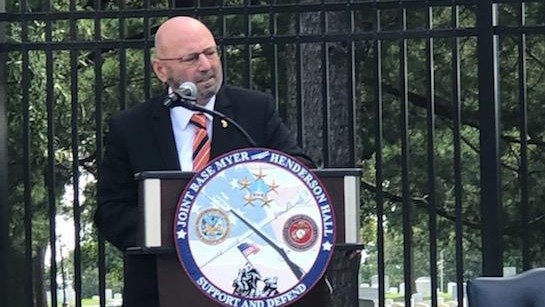Arthur Sinodinos leads US tribute to wartime air crew
Australia’s deadliest air disaster, but probably the least well known, has been commemorated in Washington DC.

Australia’s deadliest air disaster, but probably the least well known, has been commemorated in Washington DC at a small ceremony at Arlington Cemetery.
The Bakers Creek Memorial Observance paid tribute to the 40 American soldiers, almost all in their early 20s, who died around 6am on June 14, 1943, after their plane crashed soon after take-off, 8km south of Mackay, Queensland.
“These young men, who were a long way from home, fighting a very tough battle in New Guinea, stopping an enemy that was primed to take Australia if the US had not been there,” said Australian ambassador to the US, Arthur Sinodinos, who laid a wreath, and paid tribute to soldiers and the US alliance.
Wartime censorship, meant to keep up morale and avoid controversies around responsibility, prevented newspapers and radio from reporting the crash, which left only one survivor among the six crew and 35 passengers.
In a moving ceremony of around two dozen military, diplomatic and civilian attendees, Robert Cutler, executive director of the Bakers Creek Memorial Association, read aloud the names of the soldiers, from 23 US states, who died.
“A similar ceremony was held near the crash site at Bakers Creek, an annual duty of the Mackay regional council performed for the past 29 years,” said Dr Cutler, whose late father, a US officer, closed the door of the ill-fated plane before it took off.
In Mackay, a day earlier, 90-year-old Terry Hayes, a retired journalist of 47 years on the Daily Mercury, gave a moving tribute. “Mackay gave them 10 carefree days, far from the rigours of the steaming jungles and the desperate war being fought there,” he said.
The men were part of around 200,000 US troops stationed in Australia during the war. “In their last few days of leave they had sent postcards and messages home and even bought souvenirs to take home when the war is over,” he added.
Colonel David Bowling, Commander of the Joint Base Myer-Henderson Hall, spoke of the frustration and heartache of the families who weren’t told the cause of the deaths of their sons and brothers.
“I think it was 15 years until the cause was publicly released of how the accident actually happened,” he said.
“I was also struck by the similarities between their generation and our generation – December 7, 1941, which will live in infamy, and 9/11, both very similar in nature, rallying calls to the nation,” the colonel said.
Mr Sinodinos pointed out in his remarks that it was 20 years since former prime minister John Howard invoked the ANZUS alliance, since that tragedy, and 70 years since the ANZUS alliance itself was signed in San Francisco in 1941.
“One the most enlightened acts in the history of the 20th century was the way in which the US after WWII brought friends and foes together to build the global rules based order that underpins our peace and prosperity,” Mr Sinodinos said.
Covid-19 travel restrictions prevented a representative of the Mackay branch of the RSL, who usually features in the ceremony, from attending.




To join the conversation, please log in. Don't have an account? Register
Join the conversation, you are commenting as Logout